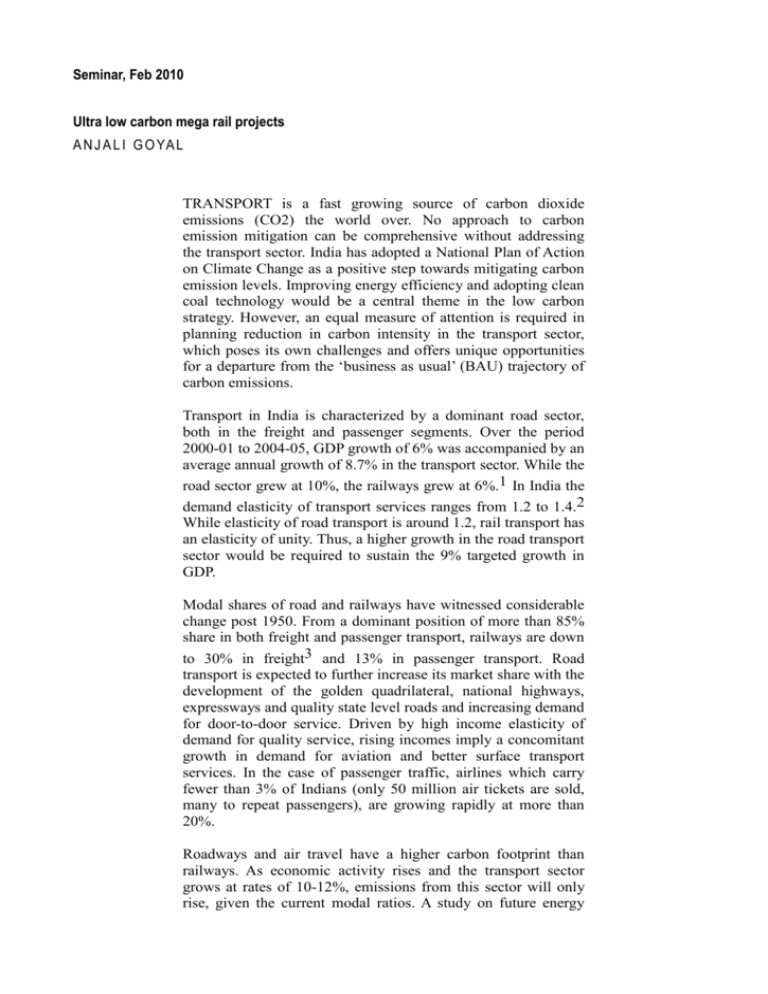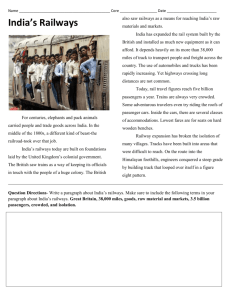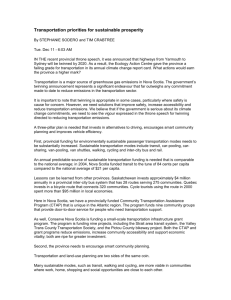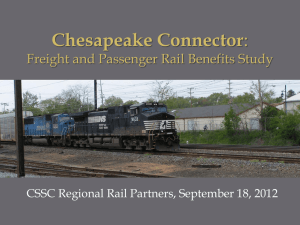ultra low carbon mega rail projects
advertisement

Seminar, Feb 2010 Ultra low carbon mega rail projects A N J A L I G O YA L TRANSPORT is a fast growing source of carbon dioxide emissions (CO2) the world over. No approach to carbon emission mitigation can be comprehensive without addressing the transport sector. India has adopted a National Plan of Action on Climate Change as a positive step towards mitigating carbon emission levels. Improving energy efficiency and adopting clean coal technology would be a central theme in the low carbon strategy. However, an equal measure of attention is required in planning reduction in carbon intensity in the transport sector, which poses its own challenges and offers unique opportunities for a departure from the ‘business as usual’ (BAU) trajectory of carbon emissions. Transport in India is characterized by a dominant road sector, both in the freight and passenger segments. Over the period 2000-01 to 2004-05, GDP growth of 6% was accompanied by an average annual growth of 8.7% in the transport sector. While the road sector grew at 10%, the railways grew at 6%.1 In India the demand elasticity of transport services ranges from 1.2 to 1.4.2 While elasticity of road transport is around 1.2, rail transport has an elasticity of unity. Thus, a higher growth in the road transport sector would be required to sustain the 9% targeted growth in GDP. Modal shares of road and railways have witnessed considerable change post 1950. From a dominant position of more than 85% share in both freight and passenger transport, railways are down to 30% in freight3 and 13% in passenger transport. Road transport is expected to further increase its market share with the development of the golden quadrilateral, national highways, expressways and quality state level roads and increasing demand for door-to-door service. Driven by high income elasticity of demand for quality service, rising incomes imply a concomitant growth in demand for aviation and better surface transport services. In the case of passenger traffic, airlines which carry fewer than 3% of Indians (only 50 million air tickets are sold, many to repeat passengers), are growing rapidly at more than 20%. Roadways and air travel have a higher carbon footprint than railways. As economic activity rises and the transport sector grows at rates of 10-12%, emissions from this sector will only rise, given the current modal ratios. A study on future energy and emission trends for India has projected an almost five-fold increase in transport related emissions during 1995-2035, the present CO2 emission share of 11% cascading to a massive 21%.4 With or without carbon, peoples’ lifestyle choices are difficult to dictate. A gamut of socio-economic factors – income levels, frequency of trips, desired comfort levels, ease of access, peer group association and, increasingly important, an individual’s self-identity – govern choice of transport. The choice of commercial transport is driven by a business entity’s instinct for economic survival, overall costs and convenience of logistics. Governments cannot enforce their will on choice of transport. Taxes can make certain high carbon emitting modes costly, but people may still prefer to pay and use them because of lifestyle choices or overall economics. The result of surveys conducted by NCAER indicate that households categorized as ‘consuming class’ and ‘climbers’ grew from 76.6 million households in 1994-95 to 86.6 million in 1995-96, and the numbers are rising steadily. These numbers are comparable to other fast developing countries like Mexico, Brazil and China. The obvious lifestyle changes in the Indian context imply that as income levels improve, demand will rise for better access to basic facilities like education, health, transportation, ownership of homes, relative ease in access to cooking fuel – from burning of wood and cowpats to kerosene stoves/LPG cylinders, faster public transport and ownership of personal, time-saving motorized transport. Even rural households are increasingly opting for ownership of tractors, scooters, motor bikes, three-wheeler cargo carriers and other consumer essentials. Rising urbanization culminates in perceived constraints on desired mobility for large numbers of people and socioeconomic exclusion of low income populations unable to afford alternatives. Conventional road based public transport like coaches and buses, and no-frills budget trains are trapped in congestion, leading to unreliability and incapacity to offer an effective alternative to private cars. There is a pent-up demand for faster, more comfortable motorized transport for intercity mobility. As India encourages huge investments in intercity expressways and national highways with a view to unlocking traffic congestion, these costly road network improvements and traffic systems are overtaken in no time by further accelerated growth in traffic. As the ‘consuming class’ grows in numbers there will be a sharper rise in demand for automobiles. There is nothing to suggest that India will witness a different trajectory in lifestyle changes of a growing economy, different from the stages that today’s developed countries passed through. Studies project that the number of cars in India will increase from eight per thousand persons to 382 by 2050, similar to the pattern of growth evidenced by Brazil, China and Mexico. The unprecedented growth of over 20-30% in car sales even in an economic recovery year 2009-10, is a startling forewarning of the shape of things to come for people concerned about GHG emissions. Unlimited use of motor cars for intercity movements and the resultant cascading emissions and road network gridlocks should now compel our planners to look for new, safer, low emission, cost effective ways of moving people and goods between cities. Freight transport poses similar issues. Roads account for the majority share of freight movement. Ownership of commercial vehicles is mostly in the unorganized sector and the vehicle fleet is characterized by low fuel efficiency and payloads. Advent of more highways and expressways has only increased expediency of freight movement by roads. Highways cannot contribute significantly to a departure from the ‘BAU’ level of emissions. The price of oil is not showing a steady enough increase to permit major shifts in sourcing of hydrocarbon based fuels. Little hope can be pinned on biofuels for emission reduction. Airlines have an even higher emission level, with an added impact of high altitude emissions. Departure from the BAU emission trajectory requires that major public transport systems be designed as substantially low carbon systems. Capex savings and increased patronage by rail users through a compellingly attractive marketing concept, including rewards for such patronage accruing to the users (not investors alone) in respect of comfort, higher speed, frequency, punctuality, modern rolling stock, tempting pricing and quality of service alone will attract and wean away automobile users from addictive highway rides. The Dedicated Freight Corridors (DFC) project aims to separate freight and passenger rail operations. The Eastern (LudhianaKolkata) and Western corridors (Delhi-Mumbai) are entirely new, mostly double line rail corridors that will run along the existing alignment traversing 3289 route kms. Well planned mega logistics hubs will be part of DFCs to facilitate intermodal transfers. A North-South corridor (Delhi-Chennai), East-West corridor (Kolkata-Nagpur-Mumbai), East Coast corridor (Kharagpur-Vijaywada), and Southern corridor (Chennai-Goa) are also under consideration. Travelling on dedicated tracks, with stretches of elevation to avoid acquisition of farm land or disturbing populated urban habitats, at speeds of 300 km/hr, High Speed Rail (HSR) will shrink journey times between cities for distances up to 500 km by two hours. The land required will be less than half of that needed for expressways. HSR is ideal for dense passenger movement routes connecting metros and en route tier II/tier III cities. The railways are initially pursuing feasibility studies for Delhi-Chandigarh-Amritsar, Ahmedabad-Mumbai-Pune, in collaboration with concerned state governments. Other corridors being pursued independently by state governments include Vijaywada-Hyderabad-Vishakhapatnam, Bangalore-Hubli, Thiruvananthapuram-Kannur and Mumbai-Nagpur. DFC and HSR are by no means a business as usual transport strategy. These projects can revolutionize transportation and save several million tonnes of CO2 emissions per year through modal shift from road to rail. However, implementation of this strategy is fraught with complexities. Carbon mitigation policymakers and regulators engaged in carbon footprint measurements have not yet accepted an intermodal shift from road to rail as a truly measurable mitigation strategy, possibly because these multi-billion dollar rail construction projects have their own large measurable carbon footprints. If railways were to talk about advantages of consequential mode-shift, the project should have carbon neutrality attributes for itself throughout the project design and implementation phases. The railways need to identify and measure emissions of mega rail project-related construction and operation activity packages, with clear intent of neutralizing or offsetting their emissions. They should facilitate an impartial emission audit by competent, reputed, and neutral not for profit agencies with some valid measurable evidence to establish mode shift. The DFC and their several feeder routes will operate on electric and diesel traction. Both have their own share of emissions. While combustion of diesel oil emits 0.1647 kg of CO2 per equivalent kwh of energy, coal based thermal power propelled electric trains emit 0.2632 kg CO2 per kwh.5 The process of manufacturing and erecting overhead equipment adds to CO2 emissions. While diesel sees a 50% loss of heat in the power unit, electric traction loses 40% of energy in generation and transmission. Thus both options offer different challenges to improve energy efficiency. Two major initiatives by Indian Railways in the recent past are the successful trials of biofuel blend diesel locomotives and resurrecting production of 3-phase electric locomotives with regenerative braking features. The first successful trials of biofuel blend in diesel locomotives started in 2003 with Southern Railway preparing its own biodiesel using Pongammia Pinnata. Used cooking oil was also collected from hotels. The Perambur loco works currently produces 5000 litres of biodiesel/month. All necessary engine test bed trials for use of B10 blend of biodiesel for diesel locomotives are complete. With increased availability of biodiesel fuel, the railways can target a 5% biofuel blend in diesel to reduce CO2 emissions by 2%. The WAG 9, WAP 7 and WAP 5 series of locomotives produced by Chittaranjan Locomotive Works and newly proposed 9000/12000 hp heavy haul locos for DFC are the stars in clean regenerative power. The architecture of these locos enables them to work as generators while the loco brakes.6 The advanced control algorithm of the front-end Pulse Width Modulation Converters of the loco permits the loco to deliver 6000 hp of power at the wheels even at 100 km/hr speed (for WAG 9 freight locos) while pulling/hauling the trailing load. The same equipment permits the locomotive to be used as a mobile generator while braking by converting the traction motors which normally drive the wheels, to be in turn driven by the wheels and behave as generators. Figures available prove that on level sections, the loco generates around 10% of energy consumed and on graded sections up to 30%. As of now, 300 WAG 9, WAP 7 and WAP 5 locos running on the network annually save about 100 million units of energy, saving 105 tons of CO2 per annum. GE transportation has developed the Evolution Series diesel locomotives, presently used extensively in China, which are 5% more fuel efficient. A single loco is stated to be capable of saving approximately three lakh gallons of diesel fuel and corresponding carbon emissions, during a 20 year lifecycle.7 Diesel locomotives with hybrid features and fuel efficient ‘stop start’ idling reduction technology are also available now.Under electric traction, DFC, mega logi-parks and HSR would require about 1.5 billion kwh electricity annually. The feeder lines of DFC may require 90 million litres of diesel oil. If the projects are to be designed with ultra low carbon imprint, sourcing of clean power will have to be from nuclear, hydel and solar to ensure offsetting. Considerable energy and emissions can also be saved through control of energy flows from the grid to the track. Energy consumption can be reduced through weight reduction of bogies, rolling stock bodies and electrical equipment and aerodynamic designs. Frequent starts and stops can be avoided to save energy once the freight and passenger operations are segregated on DFC routes. Energy wastage takes place on almost all routes on Indian Railways when trains are repeatedly regulated for operational reasons or engineering speed restrictions for track repairs/weak bridges, etc. Improved maintenance practices in DFC and HSR will minimize this wastage. The use of waste blast furnace slag instead of cement for new station terminals and logistic park buildings, better water and waste management systems, adoption of LEED standards, station and line side facilities/equipment powered from solar/wind energy will further lower the carbon footprint. Large scale use of photovoltaic solar energy on station roofs and windows, roofs and sidewalls of warehouses, and so on, will generate clean energy, reducing thousands of tons of emissions. Mere construction of dedicated freight corridors and high speed train corridors will not lead to the inter-modal shift to rail, necessary for a substantial dent in burgeoning carbon emissions in the transport sector. A train can take the freight equivalent of more than 200 trucks off the highways. Even today, if railways were to increase their freight market share by a mere 10% shift from road to rail, it would result in reduction in CO2 emissions by 16.35 million tons annually. However, despite 63,273 route kms, Indian Railways share of transportation has only witnessed a declining trend. The seamless line capacity created on this new infrastructure must be optimally utilized by providing customized, damage free services for time sensitive consignments in specialized rolling stock like the FEMU/Cargo Sprinter services and design essentials like timetabled train movement and open access. Liberal space envelopes will facilitate rolling stock with more payload, economizing on costs per net ton km carried to drive down tariffs. Strategic logistics hubs with large scale warehousing facilities, product assembly, service centres for packaging, kitting, forwarding, and so on, will help forge close interlinkages with supply chain stakeholders – road hauliers and warehouse service providers – so that shippers are able to move cargo of all sizes over long distances on rail, with trucks providing the door to door support services. Deployment of special purpose stock like road-railers8 and Ro-Ro services will strengthen supply chain services. HSR will fill a current vacuum in transport products available in the country as India does not have high speed trains that run at top speeds of 300 km/hr covering distances of 500 km in less than three hours.9 The project design will have to cater to the demand for faster but more comfortable transit, recognizing the money value of time in a growing economy and the income elasticity of demand for quality services. HSR’s big advantage is that it can string four to five cities per trip with high frequency intercity services all in a matter of three hours. A host of value added services like door to door services to encourage leaving your car behind would come into play to wean travellers from road and air for the selected destinations. The DFC can wean away long distance road movement on to rail over the stretch of the Eastern and Western corridors, reducing the need for long haul by road. The road travel saved is assessed at nearly 5000 billion ton km over a period of 16 years. As regards fuel efficiency, a World Bank study has established that in India, carbon emissions by road are 135.9 gm/ton km against 13.5 gm/ton km for trains. Thus, the two freight corridors have the potential to save 350 to 500 million tons of CO2 over a period of 16 years. With an additional four corridors this saving will increase to more than a billion tons. Similarly, HSR can effect substantial intermodal shift from road and air to rail for distances upto 500 km, cutting distances travelled on road and easing congestion on highways. Carbon emissions on HSR in Europe are 7.7 times lower than the average car and 3.5 times lower than green cars (Toyota Prius).10 Thus, a single HSR corridor can save 14.67 million tons of CO2 emissions over a period of 16 years. Thus road vehicle displacement on to rail leads to substantial carbon saving in terms of fuel efficiency. A study by TERI pegs the minimum required cumulative CO2 emission reduction during 2001-2036 at 11 billion tonnes through various energy efficiency strategies, while sustaining an 8% annual growth rate. In this context while projects such as the National Solar Mission, nuclear power projects and adoption of ultra super critical technology for power plants and retro-fitment of existing power plants will help in meeting this target one must not forget that mega projects like DFC and HSTs offer carbon savings of a similar magnitude in the transport sector. These projects must facilitate stakeholder confidence since investments are dictated by rates of return and funds for financing by clearly defined project revenue streams. Policy supported low carbon mega rail projects will generate economies of scale for viable investment in rail based infrastructure – low carbon construction, fuel efficient rolling stock, hydel power equipment, solar photovoltaic cell manufacturing and other fuel efficient industries – enough to overcome the initially higher upfront costs. Assured patronage will also come from projects designed for intermodal shift. These projects are more amenable to branding and ability to give pass through rewards for patronage. With manifold low carbon attributes, the projects are expected to become a brand for low carbon transport. At the same time, user benefits will also be predefined in terms of diamond grams11 for passengers patronizing HSR and shippers preferring DFC to road. Climate change evokes thoughts of catastrophe, while de-carbonization measures trigger fears of burdensome levies and costlier alternatives. There is thus a need to make ultra low carbon public transport alternatives such as HSR and DFC as admirable and fashionable lifestyle brands. * This article is based on a presentation by the author at the World Transport and Energy Forum 2009, organized by the World Bank in Washington. Footnotes: 1. Working Group Report on Road Transport, XI Plan. Planning Commission, Government of India, New Delhi. 2. India Transportation Infrastructure http://www.weforum.org/pdf/India/Infrastructure.pdf Blueprint 3. Ronald H. Ballou and Samir K. Srivastava, Business Logistics/Supply Chain Management. Dorling Kindersley (India), New Delhi, 2007. 4. P.R. Shukla, Debyani Ghosh and Amit Garg, Future Energy Trends and GHG Emissions for India http://www.decisioncraft.com/energy/papers/ecc/eghgma/India/e t.pdf 5. http:xtronics.com/reference/energy_ density.htm, USEPA www.epa.gove/otaq/ climate, Modern Diesel Loco estimated fuel data, Power Plant Engineering by A.K. Raja. 6. Though it is kinetic energy recovery in its attributes, it is more akin to co-generation. The energy feed to this generator is the kinetic energy of the moving train. 7. Thomas L. Friedman, Hot, Flat, and Crowded, Penguin, New Delhi, 2009. 8. Road-Railer is the brand name for method of converting a road going articulated semi trailer into a rail going wagon. The road-railer has road wheels, on which the chassis can travel on road, with a loaded container. While in the rail mode, the road wheels are retracted and the chassis couples up with the next one with both ends being lowered on to rail bogies provided with modified bolsters. 9. For more details on high speed trains, see R. Sivadasan and Anjali Goyal, ‘A Case for High Speed Trains in India’, The Asian Journal 14(1), Asian Institute of Transport Development, New Delhi, September 2007. 10. James Strickland, Energy Efficiency of Different Modes of Transport, July 2006. 11. Diamond is the purest form of carbon.








